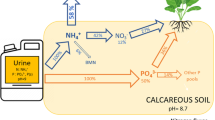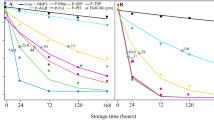Abstract
Phosphorus compounds frequently are mixed with urea containing materials for economy in fertilizer operations. There is little published information on NH3 losses from surface application of these mixtures. However, there is evidence that P can react and precipitate with adsorbed and added Ca and increase the potential for NH3 loss. This paper compares NH3 losses from surface applied urea plus KCl or CaCl2 in the presence of 5 common P sources. The N, with Ca, K, and P salts, was surface-applied to a calcareous (Harkey) and an acid soil (Cuthbert) in a laboratory and the NH3 losses determined by passage of the exhaust air through a 2% boric acid solution. Ammonia losses were increased with (in the presence of KCl or CaCl2) KH2PO4 (KP) (calcareous soil only) and K2HPO4 (K2P), unaffected by Na5P3O10 (PP) but decreased with Ca(H2PO4)2 (CaP) and H3PO4 (HP) (No HP or PP applied to the acid soil). Urea which hydrolyses in environments with lower soluble and desorbable Ca levels is susceptible to higher NH3 losses. The effectiveness of KCl for control of NH3 loss depended on the existence of desorbable Ca to react with the decomposing urea. Therefore the deleterious impact of P on NH3 loss was greater with KCl than with CaCl2. Adding Ca directly with the urea made additional Ca available for reaction with P and urea. Monocalcium phosphate (CaP) alone with urea, in a calcareous soil, did not reduce NH3 loss; however, NH3 loss was reduced in the acid soil. The addition of CaCl2 with urea + CaP reduced NH3 loss more than CaCl2 with urea. The HP reaction with CaCO3 was more rapid and complete than occurred with the acidic CaP. Sodium tripolyphosphate (PP) with urea had little impact on NH3 loss over that produced by the KCl or CaCl2 salts alone. The HP and CaP chemicals did not appear to function strictly as acid sources (calcareous soil). The Harkey soil has 8% CaCO3 which would appear adequate to neutralize any acidity introduced by the P fertilizers. The explanation may lie in double salt formation between the Ca-urea-P materials.
Similar content being viewed by others
References
Dick RP and Tabatabai MA (1986) Hydrolysis of polyphosphates in soils. Soil Sci 142: 132–140
Fenn LB and Kissel DE (1973) Ammonia volatilization from surface applications of ammonium compounds on calcareous soils. I. General Theory. Soil Sci Am Proc 37: 855–859
Fenn LB and Miyamoto S (1981) Ammonia loss and associated reactions of urea in calcareous soils. Soil Sci Soc Am J 45: 537–540
Fenn LB, Taylor RM and Matocha JE (1981) Ammonia losses from surface-applied nitrogen fertilizers as controlled by soluble calcium and magnesium: General Theory. Soil Sci Soc Am J 45: 777–781
Fenn LB and Matocha JE (1981) Substitution of ammonium and potassium for added calcium in reduction of ammonia loss from surface applied urea. Soil Sci Soc Am J 46: 771–776
Fenn LB, Matocha JE and Wu E (1981) A comparison of pH depression and carbonate precipitation as pathways for calcium reduction of ammonia from surface-applied urea. Soil Sci Soc Am J 45: 1128–1131
Fenn LB and Richards J (1986) Ammonia loss from surface-applied urea-acid products. Fert Res 9: 265–275
Fenn LB and Wu E (1987) Effects of ammonium fertilizer on NH3 and Ca, Mg, ammonium and nitrate content in a calcareous soil solution. Biol Fertil Soils 5: 171–174
Frazier AW, Lehr JR and Smith JP (1967) Urea-monocalcium phosphate, a component of mixed fertilizers. Journal of Agric Food Chem 15: 345–347
Gascho GJ (1986) Improving the fertilizer efficiency of urea-ammonium nitrate solutions by adding other nutrients. J Fert Issues 3: 62–65
Hons FM, Stewart WM and Hossner LR (1986) Factor interactions and their influence on hydrolysis of condensed phosphates in soils. Soil Sci 141: 408–416
Lindsay WL (1979) “Phosphates” In Chemical Equilibrium in Soils. John Wiley & Sons, New York, pp 162–209
Rappaport BD and Axley H (1984) Potassium chloride for improved urea fertilizer efficiency. Soil Sci Soc Am J 48: 399–401
Whittaker CW, Lundstrom FO and Hendricks SB (1933) Reaction between urea and gypsum. Ind Eng Chem 25: 1280–1282
Yee JY, Davis ROE and Hendricks SB (1936) Double salt compounds of urea with magnesium nitrate and magnesium sulfate. J Am Chem Soc 49: 570–571
Author information
Authors and Affiliations
Additional information
Contribution from the Texas Agric. Expt. Sta., Texas A&M Univ. System, College Station, TX 77843, USA
Rights and permissions
About this article
Cite this article
Fenn, L.B., Tatum, G. & Horst, G. Ammonia losses from surface-placed mixtures of urea-calcium-potassium salts in the presence of phosphorus. Fertilizer Research 21, 125–131 (1990). https://doi.org/10.1007/BF01087421
Received:
Accepted:
Issue Date:
DOI: https://doi.org/10.1007/BF01087421




